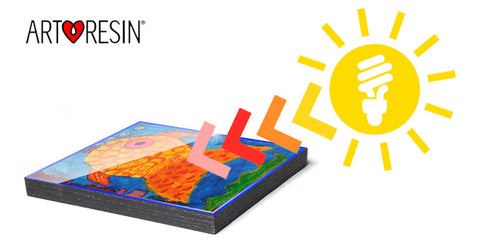When choosing an epoxy resin to cover your painting, photo, wood project, print, or other kind of craft, you may be tempted to go with whatever is cheapest. But be warned—what may at first seem relatively inexpensive could wind up costing you a ton over the long run in damaged artwork!
How Resins Behave Over Time
Once cured, epoxy resins change with exposure to UV light (as most things on earth do!). Even fluorescent indoor light can cause it to change. The most noticeable change is in respect to color. When UV light hits a resin coating, it degrades the epoxy polymers, causing ambering (i.e. a noticeable yellow discoloration). Even resin that may have started out crystal clear will soon turn a yucky yellow hue. This process and outcome is inevitable, however there are things that can be done to the chemical make-up of the resin formula to mitigate this.

What is a UV Stabilizer and How Does It Work?
Many epoxy resins on the market include a UV stabilizer (aka UV inhibitor) to help protect against yellowing, as well as other problems that epoxies are prone to (such as de-lamination, chalking, cracking and gloss loss). In truth, a UV stabilizer is necessary and effective, except when it comes to the yellowing issue. A UV stabilizer merely delays yellowing somewhat... another additive altogether is required to really combat yellowing— something by the name of Hindered Amine Light Stabilizer (HALS). Unlike UV light stabilization, Hindered Amine Light Stabilization (HALS) actually interrupts the yellowing process at the outset, making it much more difficult for yellowing to occur. HALS has been demonstrated in numerous test cases over the years to be extraordinarily effective in protecting against yellowing —there is approximately 50 years worth of this evidence available (Google it!).
Read more about HALS & UV Stabilization

Which Brand of Epoxy Resin Has the Best Performance in Terms of Yellowing?
There is only one epoxy resin formula available on the market that includes both UV and HALS stabilization: that product is ArtResin epoxy resin. ArtResin was developed specifically for use over artwork and craft projects, meaning it has been formulated to keep artwork beautiful and as the artist intended, over time. Any resin product that does not include both HALS and UV stabilization will, as a matter of scientific fact, amber and yellow over a period of a few months to a year (typically). A low quality resin product applied over artwork will deteriorate the work and decrease its value, leaving both artists and patrons frustrated and disappointed. In that sense, choosing to use a cheaper resin product is actually an extremely costly mistake.
Read more about why some epoxy brands turn yellow.
UPDATE: See empirical evidence from Atlas Labs on Testing Various Epoxy Resin Brands' Yellowing Performance
ArtResin epoxy resin has been certified as safe for home use by an ASTM board-certified toxicologist and contains no VOCs or fumes. See our SDS for more information.

